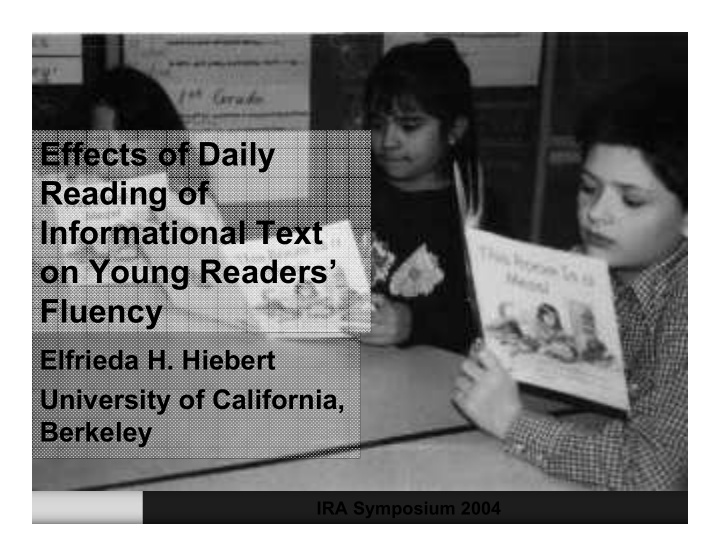



Effects of Daily Reading of Informational Text on Young Readers’ Fluency Elfrieda H. Hiebert University of California, Berkeley IRA Symposium 2004
Daily Reading of Informational Text by English Language Learners • Reasons why informational text is particularly effective with English Language Learners • Research on the effects of informational text on English Language Learners’ fluency and comprehension IRA Symposium 2004
Daily Reading of Informational Text by English Language Learners • Reasons why informational text is particularly effective with English Language Learners •for developing--and using--schemata & comprehension strategies •for developing fluency: Informational texts have features that support fluency: •fewer unique words •fewer rare words •greater repetition of hard words. IRA Symposium 2004
Why informational text for fluency? Analysis of Narrative & Informational Texts 5 4 3 0-2 Zeno et al 1995 IRA Symposium 2004
Nation’s Leading Reading Textbook & Its Science Textbook 5 5 4 3 4 3 0-2 0-2 Zeno et al., 1995 IRA Symposium 2004
Daily Reading of Informational Text by English Language Learners • Reasons why informational text is particularly effective with English Language Learners •for developing--and using--schemata & comprehension strategies •for developing fluency: Informational texts have features that support fluency: •fewer unique words •fewer rare words •greater repetition of hard words. • Research on the effects of informational text on English Language Learners’ fluency and comprehension IRA Symposium 2004
Program of Research: Weekly WCPM For 2nd Graders 4 Content 3 Text Content Text 2 Misc. Litera- Content Texts ture 1 Text Litera- ture Status Status quo 0 quo WCPM Gain per week Study 1 Study 2 Study 3 IRA Symposium 2004
Design of Current Project (Study 4) •Part of Fluency-Oriented- Reading-Instruction • 11 classes in 2 CA (FORI) (Stahl, schools with 87% native Schwanenflugel, Kuhn, Spanish speakers; 85% Morris, Morrow) free/reduced lunch; 94% •3rd year of 5 year project: parent permissions Whole school- • 2 8-week periods: Nov to implementation with mid-January; mid- “fidelity” measures January to end-March rather than control groups • Deno et al.’s Maze assessment plus a •Intervention occurs for 15- 25 minutes of a school similarly constructed day; only a portion of informational Maze test the daily 2.5 hour (& TOWRE) reading/language arts period IRA Symposium 2004
Second-Grade Fluency/Concept Curriculum LIFE SCIENCE EARTH SCIENCE PHYSICAL SCIENCE Do Animals Talk? Weather Magnets Insects Water and Us Forces Around Us Trees Rocks Thinking Like a Scientist CIVICS GEOGRAPHY/ HISTORY Children’s Games National Symbols ECONOMICS Transportation Then Being a Citizen Maps and Now Brave Americans Money Life in Colonial Jobs Around Us America IRA Symposium 2004
Example of Informational Text: Science IRA Symposium 2004
Instructional Routine FIRST READ: 1. Before students read: Have them identify what they already know about the topic. Ask them to identify and discuss at least two new and challenging words. 2. Ask students to read the passage aloud or silently, taking as much time as needed. 3. After reading, ask students to write words or phrases on graphic organizer that will help them remember the content. SECOND READ: 1. Teacher reads aloud with students at a comfortable pace. 2. Teacher reads the passage aloud with students at the target rate of one minute. 3. Have students identify one thing about the topic that is important to remember. THIRD READ (PASSAGES 1 to 4): 1. Students take turns reading aloud the passage as partners. 2. After partner reading, students write responses to comprehension questions. THIRD READ (Passage 5): 1. Ask students to read to remember but as quickly as they can. They mark down their words when the one-minute timer goes off. 2. After timed reading, students respond to comprehension questions. IRA Symposium 2004
Fluency Performances 60 50 40 30 20 10 0 Nov. Jan. March FORI 10P 25P IRA Symposium 2004
Percentile Distribution: November to March 60 40 20 0 NOV. MARCH 10 & below 11 to 30 31 to 50 51 to 70 IRA Symposium 2004
Implications •For reading instruction: Use informational text with second graders and above for developing fluency, vocabulary, and comprehension (the 3 higher-level domains of Reading First) •Find informational text that is useful for fluency as well as schemata/vocabulary instruction in science textbooks as well as trade books IRA Symposium 2004
Research studies can be found at: www.textproject.org IRA Symposium 2004
Recommend
More recommend